Note: This is leg 3 of my 6 part Switzerland journey.
In my previous post, I wrote about the incredible mountains of the Jungfrau region of Switzerland. The northern gateway to the Jungfrau region is the town of Interlaken, a convenient transit hub that gets its name from the twin lakes that flank it on either side. To the east is Lake Brienz (Brienzersee), a serene place whose shores are home to the Swiss Open Air Museum. To the west is Lake Thun (Thunersee), home to the medieval towns of Thun and Spiez. It was here that I was headed after leaving the mountains behind.
SPIEZ
I arrived in Spiez without incident and walked the short distance from the train station to my hotel. The hotel had a very spa-like feel to it (and indeed spa activities like massages and saunas were available here, but I did not avail myself of them). The helpful hotel staff showed me around and pointed out their elevated deck which had a great view of the lake.
Once I got settled in, I walked down a hill to the harbor, passing by the imposing old castle that is clearly the most distinguishing feature of this quiet little town. The harbor is small and there’s not much to do there besides wait for a boat or eat at the solitary restaurant that sits on the waterfront here. But the view was spectacular. The turquoise water had an almost Caribbean vibe, aided no doubt by the row of palm trees planted near the docks. To the right there were gorgeous mountains and dozens of sailboats docked in the water. To the left was the castle up on its hill and the gardens and vineyards that surround it. Straight ahead I could see distant landforms sticking out into the shimmering water, and an occasional sailboat or paddleboarder.
The castle wouldn’t open for touring until later that afternoon, but I walked up the stone stairs to the castle grounds, exploring the parks and gardens there which afforded excellent views of the lake. There’s an old church up here. It was a very hot day, so I sat down in the church and cooled off in that quiet and meditative space. Then I walked down a wooded path that took me to a shoreside park where people were sunbathing and children were playing in the lake. After relaxing here for a while, I made my way back up to the town center, which was pretty dead. Spiez is a beautiful and relaxing place to stay but there’s not much going on here besides the castle. I bought some groceries and took them back to my hotel room, where I ate my lunch.
Later that afternoon, I went back down to the castle and took a tour. My admission was 50% off with my Swiss Travel Pass. Spiez Castle (Schloss Spiez) was built in 933 by order of Rudolf II, King of Burgundy. The main tower and the larger complex around it were added in the late 12th and early 13th centuries. There are a number of interesting artifacts on display in the castle, from weapons and armor to furniture (including the bear throne I mentioned in an earlier post) and a variety of other objects. There’s even some medieval graffiti that was carved into the walls and has since been discovered and preserved. There is also a contemporary art exhibit about mental health that featured some intense imagery. This was the only air conditioned part of the castle, and I returned here multiple times because unlike the church, the castle was very hot and humid. At the top floor of the castle, there are watchtower windows where you can see a fantastic view of the castle grounds and the lake.
THUN
The next morning I took a train to the nearby town of Thun. I would return to Spiez by boat later, but it’s only a 10-15 minute trip by train and I wanted to get there quickly so I could see as much as possible. Unlike quiet Spiez, there was quite a bit to do in Thun.
Thun is a town of many bridges, as there is an island in the middle of it. Some of them are covered wooden bridges reminiscent of the ones in Lucerne, although these serve another practical purpose as locks to control the raging waters of the Aare River (the same river I encountered earlier in Bern) as they rush through the middle of Thun.
As soon as you get to the main historic center of town, the first thing you will notice is the tower of Thun Castle, high up on a hill overlooking the town. It’s part of a larger acropolis that also includes a historic church and some other old buildings.
I ascended a series of stairs and ramps that took me to the castle. Once again, I got in for half price with my Swiss Travel Pass.
Thun Castle (Schloss Thun) was built in the 12th century and is a national historic landmark. It has a long and sometimes bloody history, having changed hands several times during the feudal warfare that characterized medieval Europe. It continued to be used as a prison into the 1800s. Today it’s a museum and there are some interesting exhibits about the history of the castle and the region.
From the top of the castle tower, you can see an amazing view of the town, the lake, and the mountains.
After touring the castle, I visited the church that is also contained within the same hilltop citadel. Stadtkirche Thun is the main Swiss Reformed church of Thun and while the main part of the church was constructed in 1738, the tower is much older, dating back to 1330, and some elements still remain from earlier iterations of the church going back as far as the 10th century. Having been raised Catholic, it’s interesting to me to see Protestant cathedrals like this one that are grandiose in their own way but still minimalistic in design compared to a Catholic church of the same size and caliber. There’s a little museum in the attic of the church with some historic artifacts and a 3D model of the citadel.
After leaving the church, I explored the rest of the citadel, then headed down the hill and checked out the Obere Hauptgass (Main Street) area of Thun, bustling with shops and restaurants. Eventually I made my way to the Rathausplatz (Town Hall Square), which is the historic center of Thun. The stone block square is flanked by the Town Hall and other historic buildings along with restaurants and hotels, and the tower of Thun Castle looms overhead. I ate lunch here and had the best beer I would drink in Switzerland, a local red ale.
After lunch, I walked back towards river to the Mühleplatz, a popular plaza where people sit at the edge of the water. Then I crossed the bridge and continued back the way I had originally come earlier that morning. I passed the train station and the pier and walked along a riverside footpath that took me away from the center of Thun. Eventually, I arrived at a Schloss Schadau Park, home of Schadau Castle.
Schadau Castle is much newer than Thun Castle, having been built in the 1840s and ’50s. It’s more of a mansion than a genuine castle since it was built for a rich banker and never designed as a defensive fortification, but it’s beautiful and it now houses a hotel and restaurant. The castle is contained within a large park that includes a lakeside shoreline, a short nature trail, and a round building containing the world’s oldest known surviving panorama painting (created in 1814), which depicts a 360 degree landscape of Thun. Just beyond the park is a small and ancient church that was documented as far back as 762. It’s unclear to me how much of the building actually survives from the 8th century but it’s covered in frescos from the 13th-16th centuries. Apparently it was a pilgrim church for followers of the Marian order until the Reformation. It’s called Scherzligen. I found out this information later, but at the time I had just stumbled upon this empty old church in the woods and it felt like discovering a forgotten and mysterious ruin.
I had seen a lot for one day, and it was time to return to my hotel. I did so by boat, and the leisurely cruise across Lake Thun was magnificent.
MONTREUX
“If you want peace of mind, come to Montreux.”
-Freddie Mercury
The following day, I checked out of my hotel and hauled my luggage back up to the train station. I had only spent two nights on the shores of Lake Thun but I had another lake to get to. There’s a special panoramic train called the Golden Pass Express that for decades has connected the town of Zweisimmen with the French-speaking city of Montreux, on the shores of Lake Geneva. In December 2022, the Golden Pass line was expanded to include direct service from Interlaken to Montreux. Spiez is one of the first stops between Interlaken and Montreux and I had bought a ticket for a direct ride to Montreux. Unfortunately, due to construction on the railroad, I was informed that I would now have to switch trains in Zweisimmen after all. But it wasn’t really a big deal. The train I boarded in Spiez was specifically designated as a replacement for the Golden Pass and while it lacked the huge panoramic windows, it was extremely comfortable. When I arrived in Zweisimmen, we were ushered out of one train and on to the next with minimal interruption. Now I was on the actual Golden Pass panoramic train and it was windows all the way down. They brought me my pre-ordered lunch, the “vegetarian dish of the day”, which turned out to be a hummus platter with olives, bread, cheese, and mixed vegetables for dipping. My meal ticket entitled me to one free drink and I opted for the red wine. I enjoyed my meal as I watched the landscape change around me, from farmland to mountains and then down to the lake.
My hotel was very close to the train station and even closer to the waterfront. As soon as I checked in, I went right down to the promenade. Although there is no sandy beach in Montreux, it felt like a beach town. The water was absolutely gorgeous and the promenade was lined with stages and tents being set up for the world-renowned Montreux Jazz Festival, which I would end up missing by less than 24 hours.
On the Montreux waterfront, there’s a statue of Freddie Mercury, the famous lead singer for Queen who died tragically from AIDS-related complications in 1991. Freddie fell in love with Montreux and lived there on and off during the last few years of his life. He also recorded six albums there with Queen, including the posthumously released “Made in Heaven”.
After scoping out the waterfront, I boarded a boat that was scheduled to do a three hour cruise of the Montreux Riviera. Like all the other boats I had been on in Switzerland, the cruise was covered entirely by my Swiss Travel Pass. Lake Geneva (or Lac Léman as it’s known in French) is absolutely gorgeous. The lake is shared by Switzerland and France and my boat had a French flag on the bow and a Swiss flag on the stern. In addition to Montreux, the lake is lined with several other cities, towns, and villages, including Lausanne, Vevey, and at the far end, the city of Geneva. It is also home to beautiful mountains and multiple castles, including Château de Chillon which I would visit the next day. I thoroughly enjoyed my time on the water and when it was over I ate a pizza at a waterfront restaurant, and then went back to my hotel.
Château de CHILLON
The next morning I took the bus to Chillon Castle (Château de Chillon) and arrived early before it was open. This gave me a chance to explore the castle grounds from outside and get some good photos of the exterior without any people in them. Chillon is built on top of a tiny island in Lake Geneva, creating a natural moat that made it nearly impenetrable. The building was designed to fit the shape of the island, resulting in a unique layout that makes Chillon stand out, even in this region that is full of medieval castles. Château de Chillon’s history dates back at least to Roman times, when it was the site of a Roman outpost guarding the critical road through the Alpine passes. Excavations have even found artifacts from the Bronze Age here, suggesting that the strategic value of this location has been utilized for a very long time. The current castle was around as early as 1005, perhaps significantly earlier. From the mid-12th century, Chillon was occupied by the Dukes of Savoy, who kept a fleet of ships on Lake Geneva. In the 16th century it came under the control of the Swiss canton of Bern, and in 1798 is was taken over by the French-speaking canton of Vaud.
Only after I entered the gates and stepped inside the outer walls of the castle did I truly appreciate its enormity. It was like a mini-city in there, with large open courtyards and dozens of entrances and stairwells leading in all directions. Although I was among the first people to enter the castle when it opened for the day, there was a large group of school children who came in right after me, so rather than attempting to follow the route established by the audio guide (which I declined to use), I just went whichever direction the kids didn’t.
One of the first areas I explored was the massive underground dungeon. This area was used as a prison by the Savoys in the early 1500s. One of the people imprisoned there was a prominent monk and political leader from Geneva named François de Bonivard, whose suffering in Chillon was immortalized in a poem by Lord Byron. For six years, Bonivard was chained to the floor of this dungeon and you can still see the chain and the rut it left in the floor. There’s also a painting of him on display here. Bonivard and the other prisoners was rescued by a combined Genevese and Bernese force when they took over the castle in 1536.
After emerging from the dungeon, I zig-zagged my way around the castle discovering all kinds of rooms from large halls and treasure rooms to bedrooms, kitchens, and a chapel. I went up to the ramparts to get a view from the top, and I even walked through a dark secret passageway that connects two of the rooms.







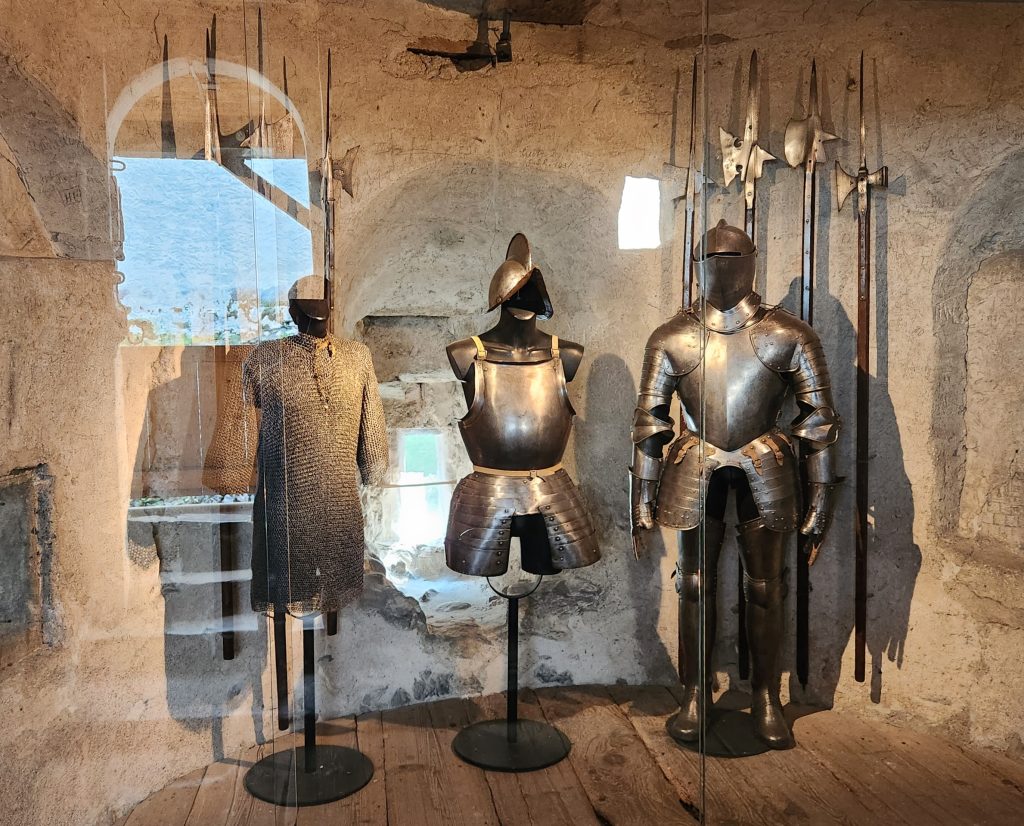


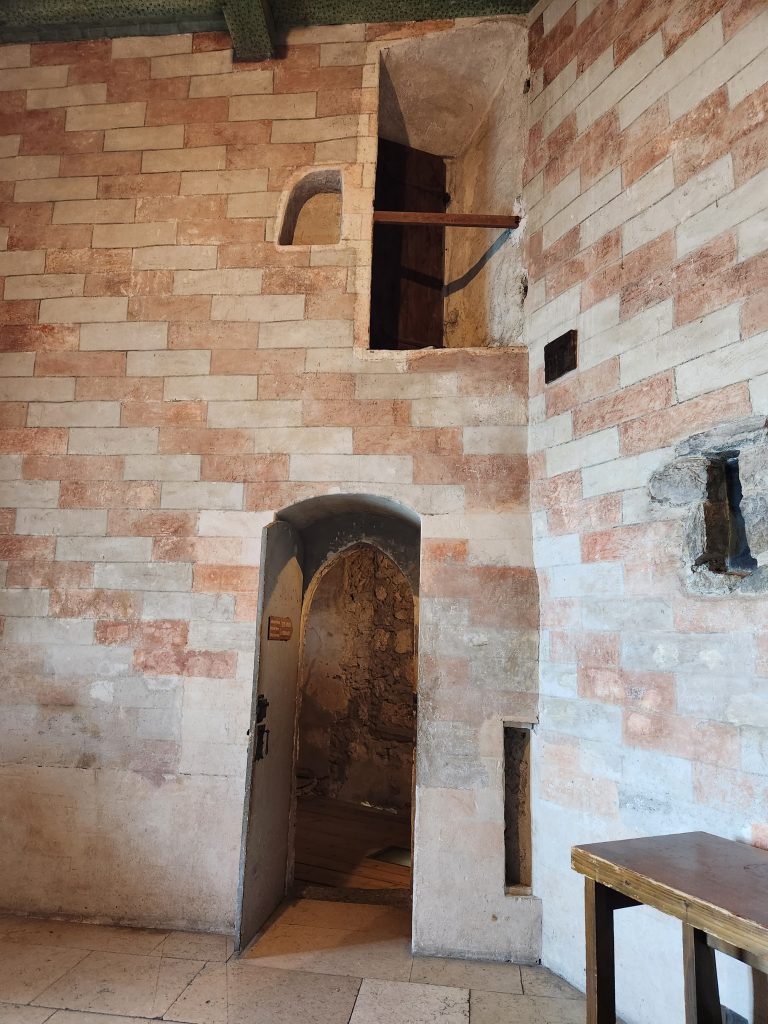

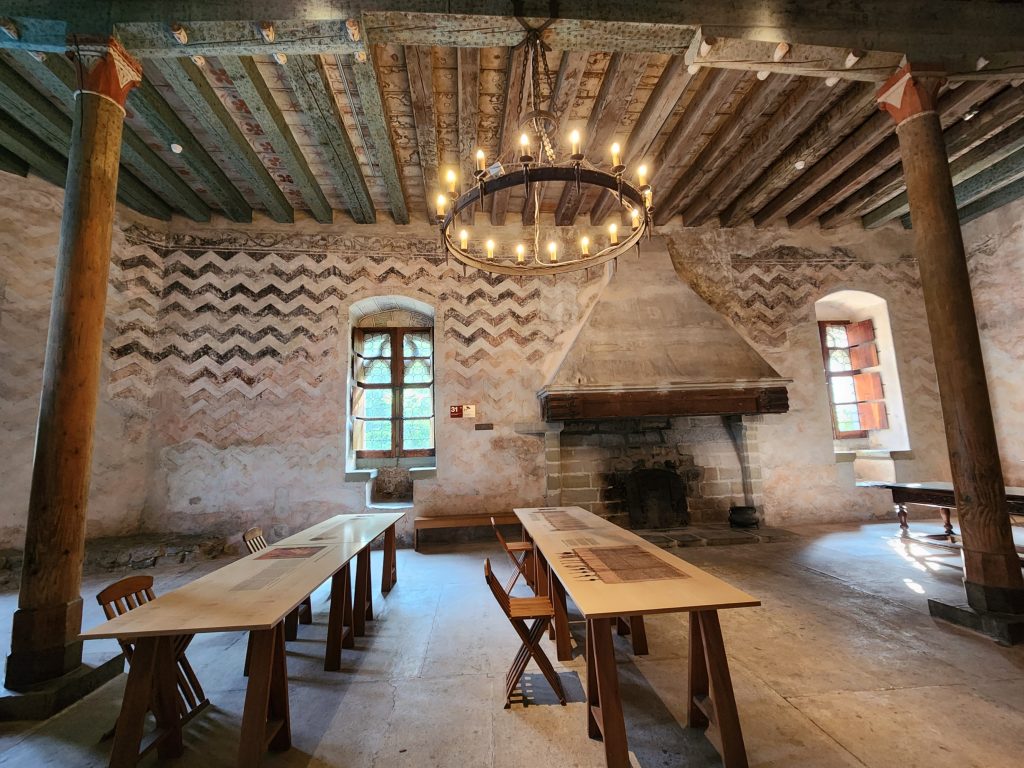



















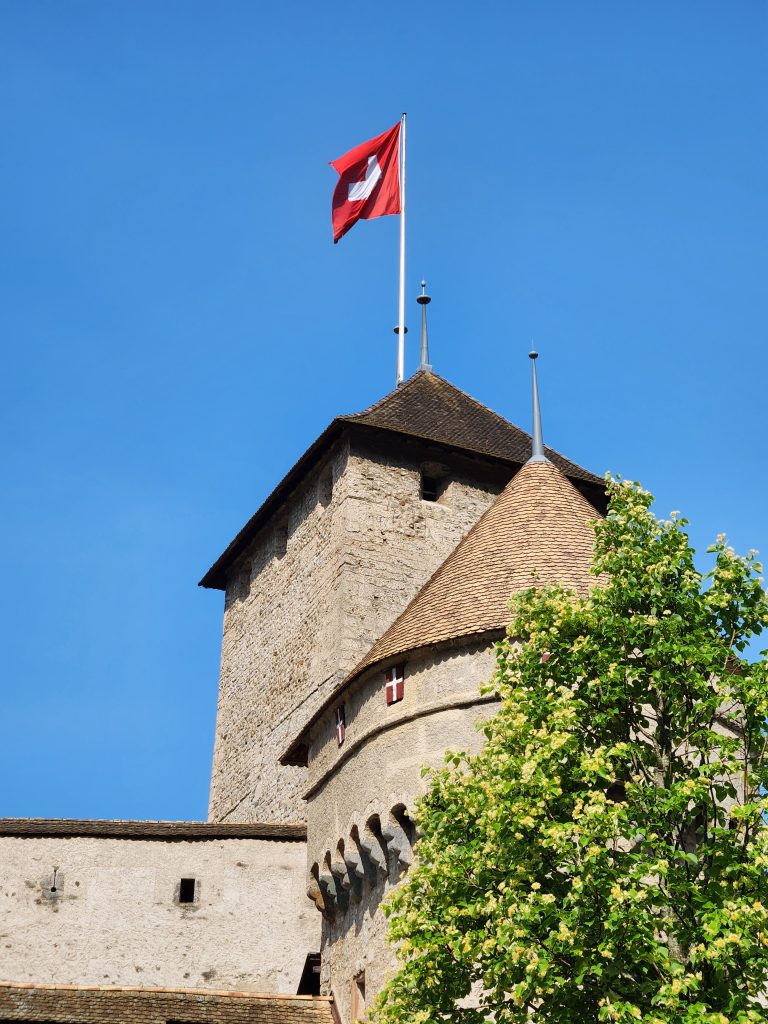
CHAPLIN’S WORLD
After leaving the castle, I caught a bus to the village of Corsier-sur-Vevey, where the legendary silent film star Charlie Chaplin lived after being deported from the United States for his suspected leftwing views by Joseph McCarthy and the House Unamerican Activities Committee. After visiting Chaplin’s gravesite, I proceeded to the Chaplin estate, where a Museum called Chaplin’s World has been set up.

Before visiting Chaplin’s World, I have to admit that my expectations weren’t all that high. I kind of expected something along the lines of the Einstenhaus that I had visited in Bern, where the exhibits were rather lackluster. Experience had led me to the conclusion that Europe in general and Switzerland in particular was a lot less flashy and high-tech than the United States when it came to this sort of thing. So I kind of laughed at the name Chaplin’s World, which evokes some over-the-top place like Disney World. As it turns out, I had grossly underestimated the place.
Chaplin’s World is split into two sections: The studio and the mansion. The mansion is the Chaplin family home, which is situated on a bucolic estate overlooking the mountains and Lake Geneva. But before you can visit the mansion, you have to go through the studio first. You have to wait outside the door until a big timer counts down to zero and the door suddenly slides open. After walking down a stairwell line with posters from Charlie Chaplin’s movies, you emerge in a red velvet theater. After a couple minutes, a film begins to play. It starts with some short scene’s from Chaplin’s many silent films, then the lights go down and a documentary about Charlie Chaplin’s life begins. It’s a very well-made and fascinating video that taught me a lot of things I didn’t know about this incredible actor, director, and human being. It was intercut with relevant scenes from his movies and behind-the-scenes footage from his personal and professional life. The movie pivots perfectly between humorous bits and more serious moments. When the film ends, the screen rises up into the ceiling, revealing a movie set of an old street lined with buildings featured in various Chaplin movies, with life-size wax figures of Chaplin and other characters, and screens playing Chaplin movies integrated into the landscape. A recorded announcement asks visitors to please leave the theater and walk through the corridor.
After making it through this initial hallway, an escalator took me down to the main part of the studio, which is mostly below ground. As I descended down the elevator, a film of Charlie Chaplin running up a never-ending set of stairs played on the other wall, like a mirror of my own experience. At the bottom of the escalator is a reimagining of the set of Modern Times, with a wax figure of Chaplin as director and a cutout of the famous wall of machinery where you can pose like Charlie being stuck on a giant gear.
The next room is full of actual archival film reels and the machines used to project them. A hand-cranked projector let me control the pace at which the frames of a Chaplin racecar movie progressed. You could watch various Chaplin movies and there was information on the walls about their production and how they were received by the public.
Next there were a series of full-scale movie sets with wax figures from a number of Chaplin’s movies, some of which you could interact with and pose with the characters. There were even costumes and props that you could try on. Scenes from the films played in the background. There was a vault with artifacts including props and items of clothing that Chaplin wore on film, a plaque from his star from the Hollywood Walk of Fame, personal letters and mementos, and more.
After making it through the studio, I walked over the the Chaplin mansion. When you enter the front door, a wax figure of an older Charlie Chaplin waves at you in front of the grand staircase. The rooms of the mansion are furnished and decorated in the way the Chaplin and his wife had kept them, including many original pieces. Signs and exhibits teach you about the ups and downs of Chaplin’s personal life and that of his family. There are wax figures of the Chaplins and some of their famous guests, like Albert Einstein. In one room you can encounter a wax figure of an elderly Chaplin sitting besides his wife watching an actual video of a family vacation with his grandkids.
On the top floor of the mansion, there’s an exhibit with props and notes from an unfinished surrealist fantasy movie called “The Freak” that Chaplin began working on in 1969. Chaplin labored on the film for years until his death in 1977. It was meant to star his daughter as the main character, a young woman with wings named Serapha. The film is full of heavy themes but was meant as a tribute to the strong women in Chaplin’s life. At the end of the exhibit is a room where you can watch a screening of the unfinished film projected onto a big screen.
VEVEY
I left Chaplin’s World thoroughly impressed. I had spent more time there than I expected to. I didn’t have a clear-cut itinerary for the rest of the day, but I decided to take the nearby funicular up to Mont Pèlerin, where you can get a nice view of the area and Lake Geneva. I was getting pretty hungry but the only restaurant nearby was even more expensive than the already sky high prices I had become accustomed to in Switzerland, so I rode the funicular back down and took the bus to the lakeside village of Vevey.
By this time it was about 2:30 PM and most of the restaurants had stopped serving food until dinner time. I had to settle for a rather crappy empanada place. They took a sad-looking empanada that had been sitting out on on a shelf and popped it into a microwave for a few minutes. The outdoor table at which I ate was surrounded by people smoking and all of the smoke blew directly into my face as I struggled to chew my rubbery empanada. The only good thing about this place is that they served the water I ordered over ice, a rarity in Europe, and one that was most welcome on this very hot day. Once again, I was astounded at how hot it can get in a country I always associated with snow. To get the taste of microwaved cheese and second-hand smoke out of my mouth, I went to a gelato stand and bought some gelato. This was much better than the empanada and I kind of wish I had just made that my lunch in the first place.
Literally next door to the empanada place was the small Museum of Photography. Although I wasn’t using my Swiss Travel Pass that day, I had been getting free transportation and discounts on museums and historic sites by using the free Montreux City Card they gave me at my hotel. With this card, my entrance to the already cheap photography museum was almost free. I had the place to myself and best of all it was air conditioned, which made it already worth the two or three dollars I paid. The museum is about the history of photography and camera technology and there are some interesting old cameras and accessories on display. I got to learn more about how early cameras worked and the different ways in which the photos were developed.
MADE IN HEAVEN
Upon leaving the Photography Museum, I spent a little time taking in the view of the crystal-clear water of the lake, then I took a bus back to Montreux. After recharging in my hotel room, I walked down the promenade to the casino, where they have a small free museum called the Queen Experience. They have on display here some of Queen’s instruments, several of Freddie Mercury’s outlandish costumes, and a number of other exhibits about Queen, Mercury, and their connection to Montreux. There was a really interesting documentary about the band playing, which I caught the second half of. It focused on their time in Montreux, Freddie’s final years, and the production of “Made In Heaven” where the surviving members of the band recorded live music with pre-recorded vocals from their recently departed lead singer.
I had a late dinner of falafel at a Middle Eastern restaurant that was 1,000 times better than my lunch, and then I called it a night. The following night would mark the beginning of the Montreux Jazz Festival but I would be many miles away in the mountain village of Zermatt. Instead of getting there the quickest way, through the French-speaking southwest corner of Switzerland, I opted to take a roundabout way that saw me backtrack to Zweisimmen and Spiez before continuing south to Visp and then Zermatt. This is because I wanted to experience the Belle Epoque train that only runs between Montreux and Zweisimmen once a day as part of the Golden Pass Express route. The Belle Epoque is an old-fashioned luxury train furnished in a historic style with wood paneling, emerald-colored plush chairs, and brass racks. The first class carriage was only about 15% full, and I enjoyed the relative solitude as the train slowly lumbered past beautiful scenery on its way to Zweisimmen.
In my next post, we will pick up my story in Zermatt, in the shadow of the Matterhorn. I’ll discuss my experience travelling on the brand new cable car across the Matterhorn to Italy. Then I’ll recount my trip on the Glacier Express to Switzerland’s oldest city, Chur. Stay tuned for all that and more next Monday!
Lastly, I want to quickly update you about the photo collection. I’ve found a solution for displaying photos from Google Photos now that my Flickr account is full, but I need a little more time to set it up. I expect the new photo collection page to be live by the time the next post drops on Monday.


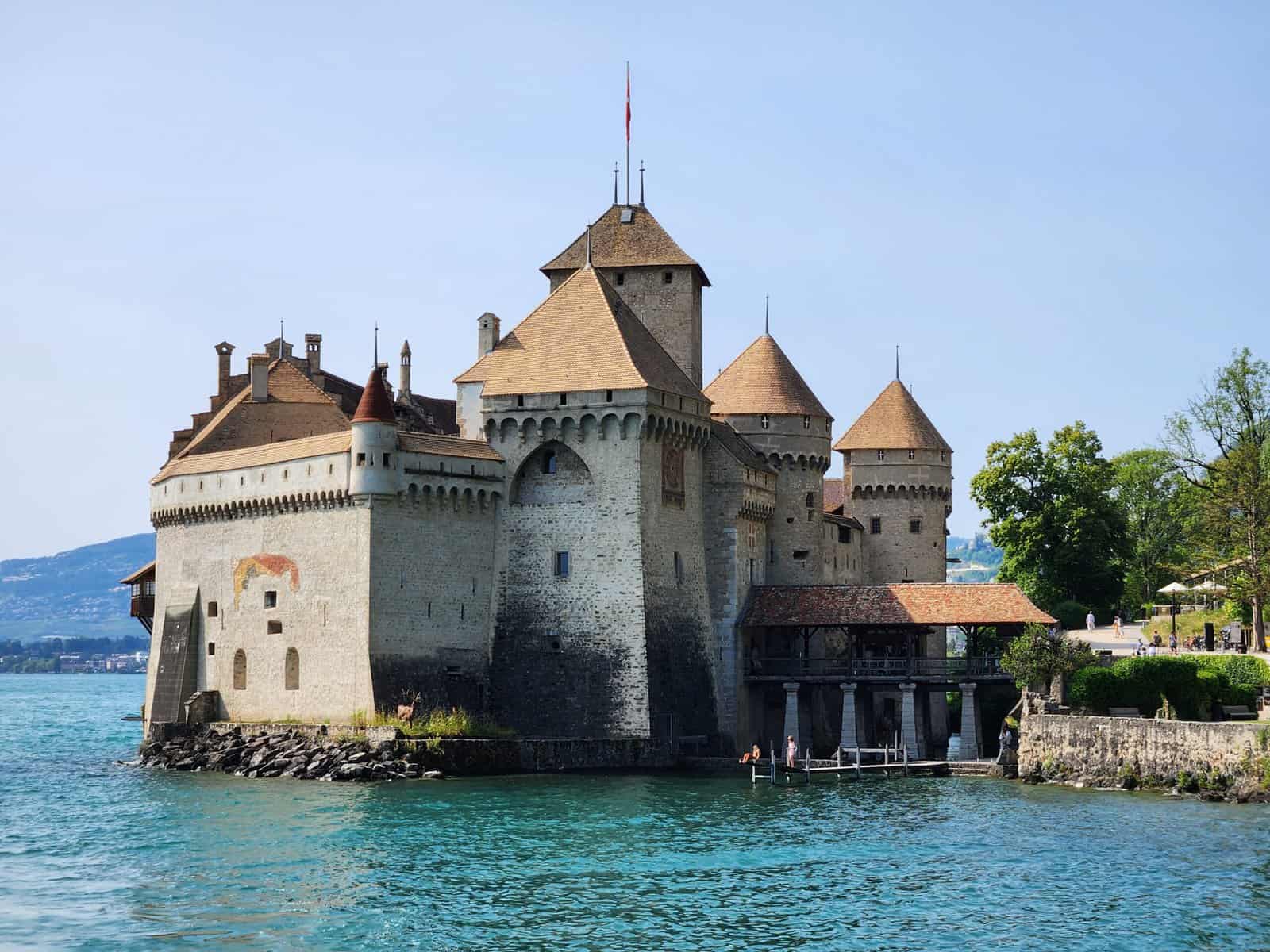

















































































































































































This is the most beautiful region! Your photos are amazing – waterfront, mountains, lake, towns and castles. You really covered a lot of ground seeing so many sights! Loved the panoramic train views and the interior of the historic Belle Epoque luxury train. I enjoyed hearing about the history of the castles and churches, and Charlie Chaplin & Queen.
Thank you. It really is amazing how much variety there is to see in Switzerland. It’s like 4 or 5 countries squeezed together into a small container.
RCAHrnTmQz